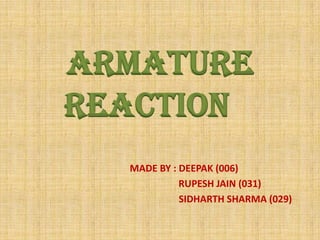
Armature reaction
- 1. ARMATURE REACTION MADE BY : DEEPAK (006) RUPESH JAIN (031) SIDHARTH SHARMA (029)
- 2. Basic terminology of a DC generator • A Generator is a machine which converts mechanical energy into electrical energy.
- 3. Stator: The stator is the fixed part of the generator that supplies the magnetic field in which the coils rotate. It may consist of two permanent magnets with opposite poles facing and shaped to fit around the rotor. Rotor: In its simplest form, the rotor is a part of generator made to rotate within a magnetic field. In actual practice, the armature is usually referred to as rotor.
- 4. WHAT IS ARMATURE REACTION ????
- 5. ARMATURE REACTION: All current-carrying conductors produce magnetic fields. The magnetic field produced by current in the armature of a DC generator affects the flux pattern and distorts the main field. This distortion causes a shift in the neutral plane, which affects commutation. This change in the neutral plane and the reaction of the magnetic field is called ARMATURE REACTION.
- 6. Armature reaction can be better understood with this figure:-
- 7. UNDESIRABLE EFFECTS OF ARMATURE REACTION 1. Armature reaction causes a net reduction in the field flux per pole. Due to this net flux decrease, induced armature e.m.f. decreases and also the torque decreases. 2. Distortion of the main field flux along the air gap i.e. MNA axis shifted. Due to this there is a problem of commutation which results in copper losses, iron losses, sparking etc.
- 8. Methods To Reduce Armature Reaction 1. By high Reluctance at POLE TIPS: At the time of construction we use chamfered poles. These poles have larger air gap on the tips and smaller air gap at the centre. These poles provide non-uniform air gap. The effect of armature reaction is more near to edge of poles and negligible near the centre of pole. If air gap is kept non uniform i.e., larger air gap at the edges(Pole Tip) and smaller near the centre of the pole and then armature flux near the pole tip decreases and armature reaction decreases.
- 9. Fig. High reluctance at pole tips
- 10. 2. By Laminated Pole Shoe: We insert Laminated objects in the pole. By having Laminated pole shoe the reluctance in the armature flux path increases. Hence the armature flux gap gets reduced.
- 11. 3. By Reduction in Armature flux: The effect of Armature Reaction is reduced by creating more reluctance in the path of Armature flux. This is achieved by using field Pole Laminations having several Rectangular holes punched in them. It gives high Reluctance in the path of armature flux. Due to this armature cross flux reduces whereas main field remains almost unaffected.
- 12. 4. By having Strong main magnetic field: During the design of DC machine it should be ensured that the main field m.m.f. is sufficiently strong in comparison with full load armature flux. Greater the main field, lesser will be the distortion.
- 13. 5) By using Inter Poles: The effect of Armature reaction is reduced by interpoles placed in between the main poles. The magnetic axis of interpoles is in the Direction of q-axis. Interpoles windings are connected in series with the armature winding. So that, interpoles flux is able to neutralize the effect of armature flux. The interpoles are narrow and tapered with large air gap.
- 14. Fig. Interpoles are added [NN & SS]
- 15. 6. By Using Compensating Windings: The Armature Reaction can also be limited by compensating windings. It is the best and most expensive methods. The compensating windings are connected in series with armature winding.
